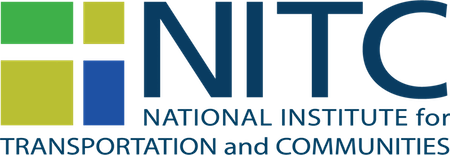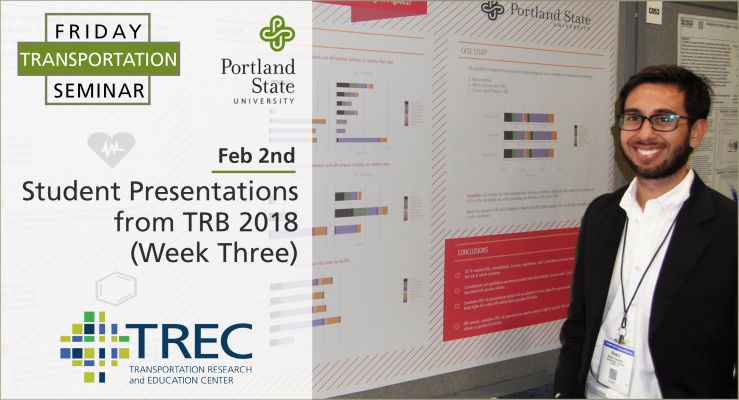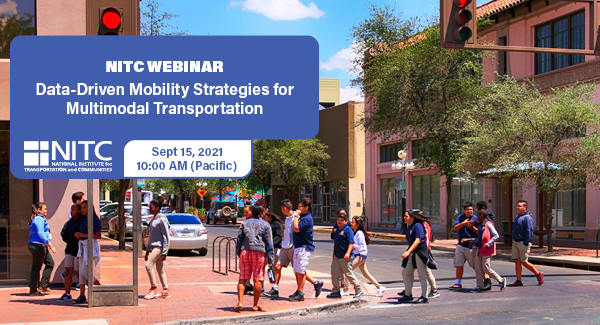Please join the Portland State University Intelligent Transportation Lab and the Oregon Transportation Research and Education Consortium as we host a Transportation Research Board webinar on climate change mitigation and adaptation, followed by an informal discussion on climate change transportation impacts and planning in the Pacific Northwest. This webinar will explore the findings of Transportation Research Board Special Report 299: A Transportation Research Program for Mitigating and Adapting to Climate Change and Conserving Energy. Committee chair, Michael Meyer, will provide an overview of the research programs recommended by the committee that can be used to develop guidance to policy makers. When: Wednesday, December 2, 2009 Where: Portland State University Intelligent Transportation System Lab 1930 SW 4th Ave, Room 315 Time: 11 am - 12:45 pm
Portland State University faculty and students presented their work at the National Urban Freight Conference (NUFC) in Long Beach, CA October 21-23, 2009. Dr. Miguel Figliozzi presented "Emissions & Energy Minimization Vehicle Routing Problem" and "A Study of Transportation Disruption Causes and Cost in Containerized Maritime Transportation." Also, graduate research assistants Ryan Conrad and Nikki Wheeler presented research projects sponsored by OTREC. Ryan presented "Algorithms and Methodologies to Analyze and Quantify the Impacts of Congestion on Urban Distribution Systems Using Real-world Urban Network Data" and Nikki presented "Analysis of the Impacts of Congestion on Freight Movements in the Portland Metropolitan Area." NUFC brings together researchers and practitioners in the public and private sectors from many disciplines within freight transportation. This conference is the only one of its kind in the US, and brought attendees and presenters from across the US, Canada and Europe.
tr*NEW* LOCATION: Karl Miller Center at PSU, 631 SW Harrison St., Room 465
*NEW* REGISTRATION: Sign up through GoToWebinar
Portland State University students share the work they presented at the annual meeting of the Transportation Research Board (TRB) 2018:
SEMINAR VIDEO
Read more
The video begins at 1:20.
View slides: Foster Presentation (PDF)
View slides: Muhs Presentation (PDF)
View slides: Wagner Presentation (PDF)
Summaries:
Evaluating Driver and Pedestrian Behaviors at Enhanced Multilane Midblock Pedestrian Crossings: Case Study in Portland, Oregon This study examines driver and pedestrian behaviors at two enhanced midblock pedestrian crossings in Portland, Oregon. One crossing is on a five-lane arterial with a posted speed of 35/45 miles-per-hour (MPH) and features six rectangular rapid flash beacon (RRFB) assemblies and a narrow median refuge. The other crossing is on a suburban arterial with four travel lanes and a two-way left-turn lane. The crossing is enhanced with four RRFB assemblies and a median island with a “Z” crossing, or Danish offset, designed to encourage pedestrians to face oncoming traffic before completing the second stage of their crossing. Approximately 62 hours of video have been collected at the two locations. A total of 351 pedestrian crossings are analyzed for driver compliance (yielding) rates, pedestrian...
Read moreSteve Szigethy and Jamison Kelleher, a team of graduate students in PSU's Master of Urban and Regional Planning program, will present their Planning Workshop project entitled "Imagine 82nd." The project engaged residents, businesses, property owners and students along NE 82nd Avenue in Portland to develop a comprehensive vision for the future of the corridor. Imagine 82nd deals with the portion of 82nd Avenue between the Banfield Expressway and NE Sandy Boulevard, 1.3 miles in length. This particular stretch is home to many retail and service businesses that typify the rest of 82nd Avenue, but it also includes Madison High School, a major corporate headquarters, and a 20-acre vacant brownfield site. At this seminar, Steve Szigethy and Jamison Kelleher will present the vision concepts they developed with the community, with particular emphasis on transportation and land use components.
The video begins at 5:54.
PRESENTATION ARCHIVE
OVERVIEW
Multimodal transportation systems (e.g., walking, cycling, automobile, public transit, etc.) are effective in increasing people’s travel flexibility, reducing congestion, and improving safety. Therefore, it is critical to understand what factors would affect people’s mode choices. With advanced technology, such as connected and automated vehicles, cities are now facing a transition from traditional urban planning to developing smart cities. To support multimodal transportation management, this study serves as a bridge to connect speed management strategies of conventional corridors to connected vehicle corridors.
The study consists of three main components. In the first component, the impact of speed management strategies along traditional corridors was evaluated. In the second component, the impacts of the specific speed management strategies, signal retiming and...
Read moreWatch video
View slides: Bell Presentation (PDF)
Summaries:
Identification and Characterization of PM2.5 and VOC Hot Spots on Arterial Corridor by Integrating Probe Vehicle, Traffic, and Land Use Data: The purpose of this study is to explore the use of integrated probe vehicle, traffic and land use data to identify and characterize fine particulate matter (PM2.5) and volatile organic compound (VOC) hot spot locations on urban arterial corridors. An emission hot spot is defined as a fixed location along a corridor in which the mean pollutant concentrations are consistently above the 85th percentile of pollutant concentrations when considering all other locations along the corridor during the same time period. In order to collect data for this study, an electric vehicle was equipped with instruments designed to measure PM2.5 and VOC concentrations. Second-by-second measurements were performed for each pollutant from both the right and left sides of the vehicle. Detailed meteorological, traffic and land use data is also...


